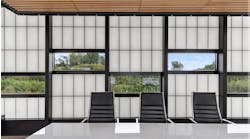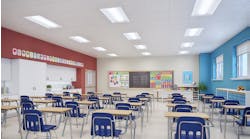Education institutions that have not pursued upgrades of the lighting systems in their facilities are missing an opportunity to significantly reduce their energy costs.
The U.S. Department of Energy’s Office of Energy Efficiency and Renewable Energy (EERE) refers to lighting upgrades as "low-hanging fruit" for schools.
"Strategies such as switching off lights, delamping, cleaning, and daylighting are simple and inexpensive," says the EERE’s Guide to Operating and Maintaining Energy Smart Schools. "Relamping, or periodically replacing groups of lamps, requires slightly more investment. Schools can install dimmers, timers, and sensors to have more control over when lights are turned on."
Lighting represents an estimated 30 percent of electricity consumption in a typical school. Retrofitting a lighting system in a school facility with more efficient equipment and adopting conservation strategies can reduce lighting costs by 30 to 50 percent, according to the federal government’s ENERGY STAR program.
The state of Delaware’s education department has compiled a checklist of best practices for energy conservation that includes many ways to illuminate facilities more efficiently:
•Have T-12 fluorescent lamps been replaced with more efficient T-8 or T-5 lamps? Have incandescent light bulbs been replaced with compact fluorescent bulbs?
Facilities that still use incandescent bulbs or T-12 fluorescent lamps may have difficulty finding replacements soon because the U.S. Department of Energy is phasing out most types of those categories because of their relative inefficiency. Switching from T-12 to T-8 lighting with electronic ballasts can reduce lighting energy by 20 to 30 percent, the EERE estimates.
•Have emergency exit signs been replaced with high-efficiency or LED signs?
•Does the school have occupancy sensors or timers to control lighting? Turning off lights in unoccupied rooms can save up to 10 percent in lighting energy, the EERE says.
•Are lighting levels in the hallways reduced when possible?
•Have the lights in the gymnasium been upgraded with more efficient lighting?
•Are gym lights turned on only when children are present and only when available daylight is not sufficient?
•Is all lighting outside a school facility turned off during daylight hours?
•Are exterior parking-lot lights turned on only for night events?
•Are house and theatrical lights in school auditoriums being used only for appropriate events?
The EERE guide also provides suggestions for improved maintenance practices that can enhance lighting efficiency:
•Establish scheduled cleaning routes for lamps and luminaires.
Replace discolored plastic diffusers in fluorescent fixtures.
•Use light-colored paints, carpets, tile and upholstery.
•In areas with similar hours of operation, replace all lamps simultaneously to reduce labor costs.
•Measure light levels in all areas.
Kennedy, staff writer, can be reached at [email protected]. Follow him on Twitter @SchoolhouseBeat.

